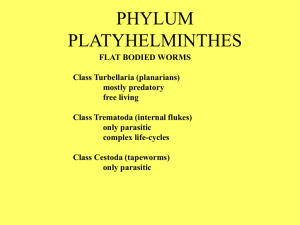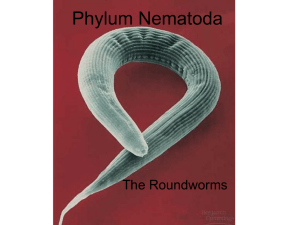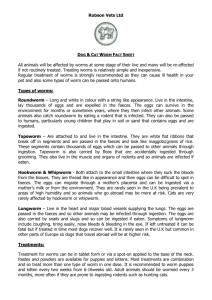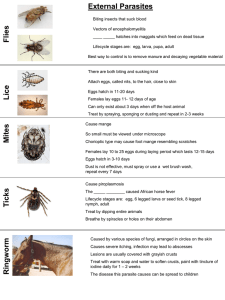Phylum Platyhelminthes. Class Trematoda. Class Cestoda. Phylum
advertisement
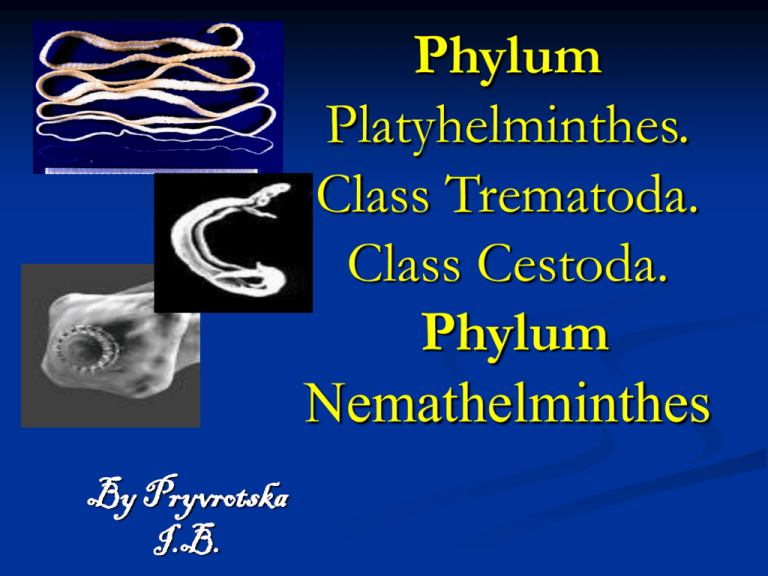
Phylum Platyhelminthes. Class Trematoda. Class Cestoda. Phylum Nemathelminthes By Pryvrotska I.B. According to the way of development parasites are classificated into biohelminthes and geohelminthes. Geohelminthes develop without intermediate hosts. Biohelminthes have complete life cycle with intermediate hosts. The flatwotms consists of some 12, 200 species, including classes of parasitic worms: Trematoda, Cestoda General characteristic of Flatworms All flatworms are acoelomate, triploblastic, and bilaterally symmetrical. flattened dorsoventrally they have a definite head at the anterior end. The most of flatworm species, in all three classes, are hermaphrodites. A single individual generally cannot fertilize itself, although exceptions do exist. General characteristic of Class Trematoda - Flattened dorsoventrally (leaf-like). - Unsegmented. - Body is covered by cuticle. - Organs of fixation: oral sucker, ventral sucker. - Genital system: Trematodes are hermaphrodites except genus Schistosoma. -The life cycle is passed in two hosts (alternation of hosts) BLOOD FLUKES - genus SCHISTOSOMA Distribution: Africa, Asia, Middle East, Latin America. Schistosoma mansoni and Schistosoma japonicum cause Hepatosplenic Schistosomiasis. Schistosoma haematobium causes Urinary Schistosomiasis. Localization: venous vessels of bowel, liver, and bladder. Morphology: atypical trematodes which the adult female nesting within a specialized groove in the body of the larger male. BLOOD FLUKES Transmission: infection through skin of larvae from snail hosts. Infective stage: cercariae. Intermediate host: snail. Definitive host: man. Mode of transmission: penetration of skin by cercarie. BLOOD FLUKES Clinical manifestations of Hepatosplenic Shistosomiasis: Clinical manifestations of Urinary Schistosomiasis: eosinophilia, granulomatous polyps in colon, Fever, anorexia, weight loss, anemia, portal hypertension, dysentery and cirrhosis of liver, pruritic skin rash. Eggs go back through portal circulation to liver, causing hepatomegaly, liver tenderness. eosinophilia, hematuria, terminal dysuria (pain, difficulty at the end of urination); obstructed urine flow. Laboratory diagnostics and Prevention: Hepatosplenic Schistosomiasis: with lateral spine in feces. Laboratory diagnostics of Schistosomiasis: eggs with eggs Urinary terminal spine in urine Prevention: involves proper disposal of human waste and eradication of the snail host when possible. Swimming in endemic areas should be avoided. LUNG FLUKE: PARAGONIMUS WESTERMANI – an agent of paragonimiasis Distribution: Far East, Central America, Africa, and India. Morphology: an egglike form of the body, from 7,5 to 16 mm. LUNG FLUKE Mode of transmission: ingestion of metacercarial cysts in crabs or crayfish. Final hosts: carnivorous mammals, pigs, humans. Intermediate hosts: 1) snail (sporocyst, redia, cercaria); 2) crabs or crayfish (metacercaria). Infective stage: metacercariae LUNG FLUKE Clinical disease: a chronic cough with bloody sputum, dyspnea, pleuritic chest pain, and pneumonia. Laboratory diagnosis: eggs in sputum or feces. Prevention: cooking crabs and crayfish properly. BILIARY (LIVER) FLUKES FASCIOLA HEPATICA an agent of fascioliasis. Distribution: endemic in Far East. bile ducts, gallbladder, and pancreas. Morphology: large size (3-5 cm) and conical form of the body sucking disks (oral and abdominal) Multibranched uterus is situated under the abdominal sucking disk. Testis are branched too and located in the middle part of the body. Localization: FASCIOLA HEPATICA Life-cycle: Final host herbivorous mammals (horses) and humans. Intermediate host — the snail Limnea truncatula. Transmission: fecaloral Invasive adolescariae. stage: FASCIOLA HEPATICA Clinical disease: Parasites obstruct bile ducts and lay eggs within them, leading to cholelithiasis (gallstones). Biliary obstruction can occur, sometimes causing biliary cirrhosis. Diagnosis: immature eggs in feces. Prevention: involves not eating wild aquatic vegetables. OPISTHORCHIS FELINEUS Opisthorchiasis. Distribution: Siberia. Morphology: flat, the length of the body 4-13 mm. In the middle part of the body there is a branched uterus. Behind it there is a round ovary. roseolla-like testis in the back of the uterus - a diagnostic sign of this worm. OPISTHORCHIS FELINEUS Life-cycle: Final host - carnivorous mammals and humans. Intermediate host 1) - snail Bithynia leachi genus 2) - fish. Transmission: ingestion of fish, which contains metacercariae. Invasive stage: metacercariae cysts in fish muscles. Localization: bile ducts, gallbladder, liver. OPISTHORCHIS FELINEUS Clinical disease: cholecystitis and cholelithiasis, hepatic colic, cirhosis. Infection can lay dormant for several years before presenting clinically. Diagnosis: immature eggs in feces, in fluid from biliary drainage, or duodenal aspirate. Prevention involves not eating undercooked or contaminated raw, frozen, dried, pickled, and salted fish; eradication of snail hosts when possible. DICROCOELIUM LANCEATUM – causes Dicrocoeliasis. Distribution: worldwide. Localization: bile ducts, gallbladder and liver of mammals (cattle, horses). Very rare in humans. Morphology: the worms are 1 cm long with lanceolate form of the body; Two round testis are situated in the front of the body - the diagnostic sign of this worm. Transmission: ingestion of plants with the ants, which contain metacercariae. DICROCOELIUM LANCEATUM Invasive stage: metacercariae. Life-cycle: Final host - herbivorous mammals (cattle, horses). intermediate host 1- the snail of Zebrina and Helicela genus, 2- the ants Fornica genus. Clinical disease: is similar to fascioliasis. Diagnosis: immature eggs in feces. Prophylactics: eradication of the snails, ants when possible; dehelmithization of cattle. Tapeworms (Cestoda) scolex, strobila or chain of proglottids (multiple segments) of varying stages of maturity. They have no digestive tract The cestodes receive all of its nutrients be the tegument. The scolex has specialized means of attaching to the intestinal wall, namely suckers, hooks, or sucking grooves. All cestodes have stage of larva and stage of oncosphere in the life cycle. Taenia solium The adult T. solium -taeniasis solium. T. solium larvae cause cysticercosis. Distribution Teniasis and cysticercosis occur worldwide . Morphology scolex with 4 suckers and circle of hooks gravid proglottids, which have 7-12 primary uterine branches. Larva of T.solium called cysticercus. A cysticercus consist of a pea-sized fluid-filled bladder with an invaginated scolex. Taenia solium Life cycle Transmittion: fecal-oral Invasive stage: cysticerci. Definitive hosts – humans Intermediate hosts pigs Humans can be infected by eating raw or undercooked pork containing the larvae cysticercus. Taenia solium The cysticerci can become large in eye, subcutaneous tissue, brain, lung, heart, and muscle. In the brain, they manifest as a space-occupying lesion. Taenia saginata taeniasis saginata. Distribution: occur worldwide Morphology. scolex with 4 suckers without hooklets. proglottids have 17-35 primary uterine branches. Larva of T.saginata called cysticercus. Transmittion: fecal-oral Invasive stage: cysticerci Life cycle. Definitive hosts -humans Intermediate hosts - cattle Humans can be infected by eating raw or undercooked beef containing larvae. Laboratory diagnosis: gravid proglottids (with 17-35 uterine branches) may be found in the stools. Prevention. Prevention of taeniasis saginata involves cooking beef adequately and preventing cattle from ingesting human feces by disposing of waste properly. Clinical manifestation of teniasis saginata: abdominal pain, nausea, diarrhea, weight loss, infection may by asymptomatic. In some, proglottids appear in the stools and may even protrude from the anus. Diphyllobothrium latum, the fish tapeworm, causes diphyllobothriasis Distribution: Scandinavia, northern Russia, Japan, Canada, USA. Morphology. scolex with 2 elongated sucking grooves. The proglottids are wider than they are long, and the gravid uterus is in the form of a rosette. Adult worm is the longest of the tapeworms, up to 13 m. Larva called plerocercoid. Transmittion: fecal-oral. Invasive stage: plerocercoid. Definitive hosts- humans . Intermediate hosts -1)copepod crustacea -2) freshwater fish Humans infected by eating raw or undercooked fish containing plerocercoids Clinical disease: little damage in the small intestine. megaloblastic anemia occurs as a result of vitamin B12 deficiency caused by preferential uptake of the vitamin by the worm. Most patients are asymptomatic, but abdominal discomfort and diarrhea can occur. Diagnosis depends on finding the typical eggs, oval, yellow-brown eggs with an operculum (lidlike opening) at one end, in the stools. Prevention involves adequate cooking of fish and proper disposal of human feces. Hymenolepis nana (dwarf tapeworm) is found worldwide, commonly in the tropics. Morphology. It is only 2-3 cm in length. Scolex has round form and contain suckers and hooks. A neck is very long and thick. Strobila has 200 proglottides. The uterus has an excretory ostium. Eggs are released from it into the feces. Transmission: fecal-oral (by the ingestion of eggs from contaminated food or water). Invasive stage: egg. Life cycle. The eggs of H. nana are directly infectious for humans; ingested eggs can develop into adult worms without an intermediate host. Within the duodenum, the eggs hatch and differentiate into cysticercoid larvae and then into adult worms. Gravid proglottids detach, disintegrate, and release fertilized eggs. The eggs either pass in the stool or can reinfect the small intestine (autoinfection). A lot of H.nana worms (sometimes hundreds) are found. Clinical disease: asymptomatic, but diarrhea and abdominal cramps may be present. Diagnosis can be proved by observing eggs in stool. Prevention consists of good personal hygiene and avoidance of fecal contamination of food and water. Echinococcus granulosus (dog tapeworm) Mediterranean region, the Middle East, and Australian, USA (western states). Morphology. Worm is up to 3-5 mm. Scolex has suckers and hooks. A neck is short. Strobila has 35 proglottides. Posterior segment (mature) is the largest and contains uterus with the haustrums, genital pore situated in the back of the proglottid. Transmission: fecal-oral Invasive stage: egg Life cycle. Definitive hosts: dogs. Intermediate hosts: sheep, humans. Diagnosis: made by Clinical manifestations. asymptomatic, but liver cysts may cause hepatic dysfunction. Cysts in the lungs can erode into a bronchus, causing bloody sputum, end cerebral cysts can cause headache and focal neurologic sings. Diagnosis: made by routine Xray, observation of eosinophilia, serologic tests. Prevention of human disease involves not feeding the entrails of slaughtered sheep to dogs. Echinococcus multilocularis Distribution: is found in northern Europe, Siberia, Canada, the USA. - the definitive hosts are mainly foxes and the intermediate hosts are various rodents. Humans are infected by accidental ingestion of food contaminated with fox faeces. The disease occurs primarily in hunters and trappers. Within the human liver, the larvae form multiloculated cysts with few protoscoleces, proliferate, producing a honeycomb effect of hundreds of small vesicles (without fluid). The clinical picture usually involves jaundice and weight loss. The prognosis is poor. Nematodes Roundworms with a cylindrical body and a complete digestive tract including mouth and anus. They are unsegmented, pseudocoelomate worms. The body is covered with a noncellular, highly resistant coating called a cuticle. Nematodes have separate sexes; the female is usually larger than the male. The male typically has a coiled tail. The medically important nematodes can be divided into 2 categories: intestinal and tissue nematodes. Ascaris lumbricoides causes ascariasis. Distribution: worldwide. Morphology: Adult worms are creamy or pink, spindleshaped, covered by striated cuticle. Adult male about 20 cm in length, posterior end is curved ventrally; Adult female about 25-40 cm in length, posterior end is straight. Eggs are brown, oval, covered by membranes. An external membrane is tuberous Ascaris lumbricoides Mode of transmission: fecal-oral (alimentary). Humans are infected by eating eggs in soil contaminated with human feces. Ascaris lumbricoides Clinical manifestation: - larvae may lead to pneumonia, eosinophilia. - Adults -intestinal obstruction, penetration of the intestinal wall, occlusion of the bile duct, the pancreatic duct or the appendix, toxic effects (nausea, vomiting). Most infections are asymptomatic. Laboratory diagnosis: microscopic examination of faeces (eggs are oval with an irregular surface); larvae may be found in sputum. Prophylaxis: washing hands before meals; proper washing of vegetables eaten raw; treatment of patients; proper disposal of feces; health education. Enterobius vermicularis causes enterobiasis. Distribution: worldwide. Morphology: Adult female worms are up to 10 mm in length, and male worms are up to 5 mm. Eggs are transparent and colourless, asymmetrical, with thin and smooth membrane, 40-60 micro;m. Enterobius vermicularis Mode of transmission: fecal-oral (alimentary). Infective stage: eggs. The adult pinworms live in the large intestine approximately 30 days. After fertilization female worm migrates from the anus and releases thousands of fertilized eggs on perianal skin. Within 6 hours, eggs develop into larvae and become infectious. Reinfection can occur if they are carried to the mouth by fingers after scratching of the itching skin. Enterobius vermicularis Clinical manifestation: Infection is frequent among children under 12 years of age. Perianal pruritus (itching) is most common symptom. Laboratory diagnosis: the eggs are recovered from perianal skin by using the “Scotch tape” technique and can be observed microscopically (eggs are not found in the stools). Seldom adult worms can be found in the stools. Prophylaxis: keep sanitary condition, treatment of patients Trichuris trichiuria causes trichocephaliasis (whipworm infection). Distribution: worldwide, especially in the tropics. Morphology: Adult female worms are up to 5,5 cm in length, and male are up to 4 cm. The anterior end of the body is hairlike. The eggs are brown, barrel-shaped with a plug at each end, 20-50 micro;m in size. Trichuris trichiuria Mode of transmission: fecal-oral (alimentary). Infective stage: eggs. Trichuris trichiuria Pathogenesis and clinical manifestation: Adult worms burrow their hairlike anterior ends into the intestinal mucosa. They feed blood. Trichuris may cause diarrhea, abdominal pain, nausea, acute appendicitis. Most infections are asymptomatic. Laboratory diagnosis: microscopic examination of feces (finding the typical eggs). Prophylaxis: washing hands before meals; proper washing of vegetables eaten raw; treatment of patients; proper disposal of feces; health education. Trichinella spiralis causes trichinosis. Distribution worldwide, especially in eastern Europe and west Africa. Morphology: 1) The adults female worms are up to 3-4 0.6 mm; the adult male worms are up to 1.5 0.04 mm; 2) the incysted larvae (1 mm) is enclosed in a fibrous cyst wall. Localisation: small intestine (adult worms) and striated muscles (larvae). Any mammal (rat, bear, fox) can be infected, but pigs are the most important reservoirs of human disease. Infective stage for humans: larva. Mode of transmission: alimentary (eating raw or undercooked meat, usually pork, containing larvae encysted in the muscle). Trichinella spiralis Clinical manifestation: initially diarrhea, abdominal pain followed by 1-2 weeks later by fever, muscle pain, periorbital edema, and eosinophilia. Death, which is rare, is usually due to congestive heart failure or respiratory paralysis. Laboratory diagnosis: muscle biopsy reveals larvae within striated muscle; serologic test (become positive 3 weeks after infection). Prophylaxis by properly cooking pork and by feeding pigs only cooked garbage; pork inspection in slaughter houses using a trichinoscope. Ancylostoma duodenale and Necator americanus (hookworms) cause ancylostomiasis (hookworm infection). Morphology: 1) Adult worms about 1 cm in length; 2) Eggs are translucent, oval with blunt poles, 40-60 micro;m in size; 3) the rhabditiform larva is about 0.25-0.5 micro;m with rhabditiform oesophagus (1/3 body length), pointed tail end; 4) the filariform larva is about 0.6-0.7 micro;m with cylindrical oesophagus (1/4 body length), sharply pointed tail. Hookworms Hosts: humans. Mode of transmission: penetration of skin by filariform larva Infective stage: filariform larva. Clinical manifestation: 1) invasion stage (the larvae penetrate the skin): dermatitis and itching (“ground itch”); 2) migration stage: pneumonia with eosinophilia; 3) intestinal stage: anemia, diarrhea, abdominal pain, nausea. Hookworms Laboratory diagnosis: eggs in the stool; blood in the feces is frequent finding. Prophylaxis: disposing of sewage properly and wearing shoes. Thank you for attention!



